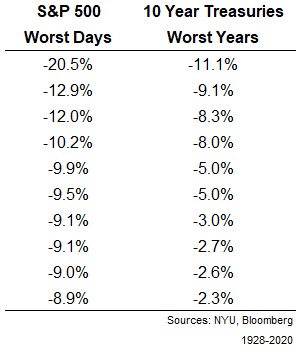It looks like you're new here. If you want to get involved, click one of these buttons!
The above will not show you how much and how long leveraged was used over the years. The managers can change it anytime.I would like to know how I can find out how much leverage is used in a fund. I use the Schwab platform. Tkx!
Historical market data can’t help you predict the future but I still find it useful as a way to understand the potential risks and rewards you can see as an investor.

Stock, Bond & Cash Returns: 1928-2020Looking through 93 years of returns for stocks, bonds and cash won’t help you predict future returns for these asset classes.
But it can give you a better sense of the risk involved in these asset classes since risk is much easier to predict than returns.
Thanks for the info. The chart in the link above is worth watching and see how SVARX compared to PIMIX and other bond fundsThe April 2020 quarterly newsletter describes the SVARX active management approach over the preceding two years. The chart provides a good visual description. Scroll down to the Active Management section of the newsletter. (Reviewing the 12/31/19 and and 3/31/20 portfolio composition in the table above that section is also instructive.)
THE FULL SPECTRUM - April 2020

Yes, this is a open secret that occasionally comes up here. I used this loophole by transferring part of a small 401k to TRP and opening a Rollover IRA in PRWCX a couple of years ago.I did find out an interesting tid-bit though, not all closed funds are really closed funds. He told me that if the amount is large enough for moving 401k funds in, that they could be deposited into currently closed funds. I've been looking at PRWCX Capital Appreciation and was told I could open an account and actually deposit funds into it if it's the right amount. Does this sound right?
Absolutely do your own diligence. First, we don't know how long or how high the leverage has been. Second, the 10 year was much higher years ago and the fund did OK too. Third, the manager has been using short positions too. Per M* fund holdings I can see 2 positions at -10.03% and -9.89Don’t forget the most important part of the fund.
The 49% leverage and the huge position in swaps.
With the recent spike in the 10 year and if the rise in interest rates continues, the higher borrowing costs will be detrimental to this funds huge position in leverage.
Do your own due diligence on this fund.
Brubeck is great, but yeah, the same refrain from Time Out on repeat is deafening.Thanks. On another note, their call wait music is the bomb...well not so much after the first 2 hours.
© 2015 Mutual Fund Observer. All rights reserved.
© 2015 Mutual Fund Observer. All rights reserved. Powered by Vanilla